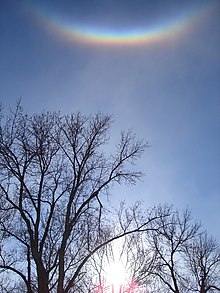Optical phenomenon

Optical phenomena are any observable events that result from the interaction of light and matter.
All optical phenomena coincide with quantum phenomena.[1] Common optical phenomena are often due to the interaction of light from the Sun or Moon with the atmosphere, clouds, water, dust, and other particulates. One common example is the rainbow, when light from the Sun is reflected and refracted by water droplets. Some phenomena, such as the green ray, are so rare they are sometimes thought to be mythical.[2] Others, such as Fata Morganas, are commonplace in favored locations.
Other phenomena are simply interesting aspects of optics, or optical effects. For instance, the colors generated by a prism are often shown in classrooms.

Scope
[edit]Optical phenomena encompass a broad range of events, including those caused by atmospheric optical properties, other natural occurrences, man-made effects, and interactions involving human vision (entoptic phenomena). Also listed here are unexplained phenomena that could have an optical explanation and "optical illusions" for which optical explanations have been excluded.
There are many phenomena that result from either the particle or the wave nature of light. Some are quite subtle and observable only by precise measurement using scientific instruments. A famous example is the bending of starlight by the Sun during a solar eclipse, a phenomenon that serves as evidence for the curvature of space as predicted by the theory of relativity.
Atmospheric optics
[edit]


Atmospheric optical phenomena include:
- Afterglow
- Airglow
- Alexander's band, the dark region between the two bows of a double rainbow.
- Alpenglow
- Anthelion
- Anticrepuscular rays
- Aurora (northern and southern lights, aurora borealis and aurora australis)
- Belt of Venus
- Brocken Spectre
- Circumhorizontal arc
- Circumzenithal arc
- Cloud iridescence
- Crepuscular rays
- Earth's shadow
- Earthquake lights
- Glories
- Green flash
- Halos, of Sun or Moon, including sun dogs
- Haze
- Heiligenschein or halo effect, partly caused by the opposition effect
- Ice blink
- Light pillar
- Lightning
- Mirages (including Fata Morgana)
- Monochrome Rainbow
- Moon dog
- Moonbow
- Nacreous cloud/Polar stratospheric cloud
- Rainbow
- Sprite (lightning)
- Subsun
- Sun dog
- Tangent arc
- Tyndall effect
- Upper-atmospheric lightning, including red sprites, Blue jets, and ELVES
- Water sky
Non-atmospheric optical phenomena
[edit]
Other optical effects
[edit]- Asterism, star gems such as star sapphire or star ruby
- Aura, a phenomenon in which gas or dust surrounding an object luminesces or reflects light from the object
- Aventurescence, also called the Schiller effect, spangled gems such as aventurine quartz and sunstone
- Baily's beads, grains of sunlight visible in total solar eclipses.
- camera obscura
- Cathodoluminescence
- Caustics
- Chatoyancy, cat's eye gems such as chrysoberyl cat's eye or aquamarine cat's eye
- Chromatic polarization
- Diffraction, the apparent bending and spreading of light waves when they meet an obstruction
- Dispersion
- Double refraction or birefringence of calcite and other minerals
- Double-slit experiment
- Electroluminescence
- Evanescent wave
- Fluorescence, also called luminescence or photoluminescence
- Mie scattering (Why clouds are white)
- Metamerism as of alexandrite
- Moiré pattern
- Newton's rings
- Phosphorescence
- Pleochroism gems or crystals, which seem "many-colored"
- Rayleigh scattering (Why the sky is blue, sunsets are red, and associated phenomena)
- Reflection
- Refraction
- Sonoluminescence
- Synchrotron radiation
- The separation of light into colors by a prism
- Triboluminescence
- Thomson scattering
- Total internal reflection
- Twisted light
- Umov effect
- Zeeman effect
- The ability of light to travel through space or through a vacuum.
Entoptic phenomena
[edit]- Diffraction of light through the eyelashes
- Haidinger's brush
- Monocular diplopia (or polyplopia) from reflections at boundaries between the various ocular media
- Phosphenes from stimulation other than by light (e.g., mechanical, electrical) of the rod cells and cones of the eye or of other neurons of the visual system
- Purkinje images.
Optical illusions
[edit]- The unusually large size of the Moon as it rises and sets, the Moon illusion
- The shape of the sky, the sky bowl
Unexplained phenomena
[edit]Some phenomena are yet to be conclusively explained and may possibly be some form of optical phenomena. Some[weasel words] consider many of these "mysteries" to simply be local tourist attractions that are not worthy of thorough investigation.[4]
See also
[edit]References
[edit]- ^ Lahiri, Avijit (2016). "Electromagnetic Theory and Optics". Basic Optics: Principles and Concepts. Elsevier. pp. 1–140. doi:10.1016/B978-0-12-805357-7.00001-0. ISBN 978-0-12-805357-7.
- ^ "Green Rays". mintaka.sdsu.edu.
- ^ "Belt of Venus over Cerro Paranal". Picture of the Week. ESO. Retrieved 14 August 2013.
- ^ "Welcome to Phenomenon! Your guide through the mysterious and unexplained". www.stateoftheart.nl.
- ^ Philip Mantle. "The Hessdalen Lights". Archived from the original on 4 April 2005. Retrieved 14 October 2017.
- ^ "UQ scientist unlocks secret of Min Min lights".
- ^ "Big Thicket National Preserve Virtual Field Trip". Archived from the original on 4 March 2005.
- ^ Gagliardi, Jason (17 November 2002). "Behind the Secret of the Naga's Fire". Archived from the original on January 19, 2007 – via www.time.com.
Source
[edit]Ozerov, Ruslan P.; Vorobyev, Anatoli A. (2007). "Wave Optics and Quantum–Optical Phenomena". Physics for Chemists. pp. 361–422. doi:10.1016/B978-044452830-8/50008-8. ISBN 978-0-444-52830-8.
Further reading
[edit]- Thomas D. Rossing and Christopher J. Chiaverina, Light Science: Physics and the Visual Arts, Springer, New York, 1999, hardback, ISBN 0-387-98827-0
- Robert Greenler, Rainbows, Halos, and Glories, Elton-Wolf Publishing, 1999, hardback, ISBN 0-89716-926-3
- Polarized Light in Nature, G. P. Können, Translated by G. A. Beerling, Cambridge University Press, 1985, hardcover, ISBN 0-521-25862-6
- M.G.J. Minnaert, Light and Color in the Outdoors, ISBN 0-387-97935-2
- John Naylor "Out of the Blue: A 24-hour Skywatcher's Guide", CUP, 2002, ISBN 0-521-80925-8
- Abenteuer im Erdschatten (German).
- The Marine Observers' Log
External links
[edit]- Atmospheric Optics Reference site


